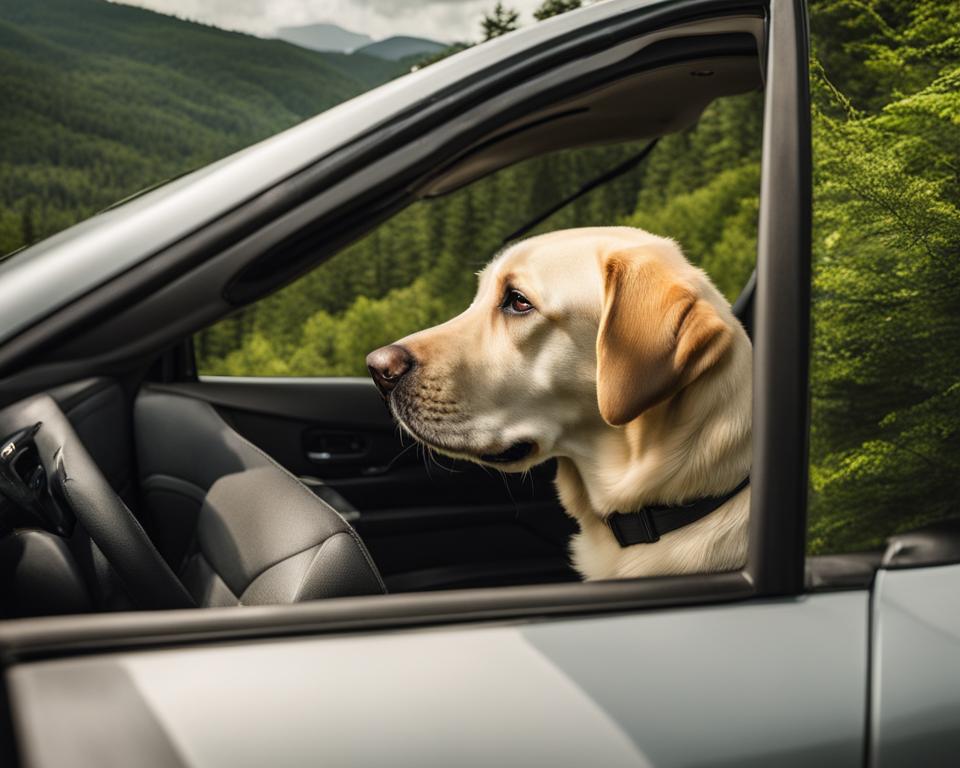If you’re like the majority of pet owners who can’t imagine leaving their furry friends behind, planning a safe road trip with dogs is essential. With nearly 95% of dog owners hitting the road for at least one pet-inclusive overnight stay, the journey can be as important as the destination. Ensuring your dog’s comfort and safety doesn’t just make the trip more enjoyable — it’s crucial. Let’s dive into some pet-friendly travel tips that will make your next traveling with dog by car adventure a breeze.
Key Takeaways
- Begin with brief, incremental car rides to acclimate your dog to travel.
- Utilize a suitable-sized carrier or a dog seatbelt to secure your pet.
- Plan ahead and pack a comprehensive travel kit tailored for your dog’s needs.
- Never feed your dog in a moving vehicle and avoid leaving them alone in a parked car.
- Carry your pet’s important documents if your journey crosses state or international borders.
- Remember to maintain a cool, calm demeanor — your pet can sense your stress.
Understanding Your Dog’s Travel Temperament
Embarking on dog-friendly road trips means adapting to your furry companion’s unique personality and needs. Before you set off on the best ways to travel with a dog, it’s essential to assess and prepare your pet for the journey ahead.
Assessing Your Dog’s Comfort with Car Rides
The first step in ensuring a stress-free trip is to understand how your dog feels about the car. Begin with sitting in a stationary car, allowing your pet to explore the space and get comfortable. Then, gradually introduce short drives, looking out for signs of contentment or anxiety. Your dog’s reactions will inform the tips for traveling with your dog that will follow.
Preparing Your Dog for Longer Road Trips
Once your dog seems acclimated to short trips, it’s time to incrementally extend the duration of the rides. Each journey should be a positive and controlled extension of the last, reducing potential anxiety. Remember, conditioning your dog for longer travels by car isn’t just about lengthening drive times; it also involves familiarizing your dog with different travel scenarios like highway speeds, bustling city traffic, and varied driving conditions.
The Importance of Regular Pit Stops
Regardless of your dog’s travel temperament, regular breaks are a non-negotiable aspect of dog-friendly road trips. Frequent stops are crucial for allowing your dog to relieve themselves, stretch their legs, and hydrate. Ideally, pit stops should consist of a brief walk and a water break, making the journey more enjoyable for both you and your pet. Strategically planning these breaks in pet-friendly and safe environments can also provide mental stimulation for your dog, keeping them engaged and happy throughout the trip.
- Introduce your pet to the car in a calm, stationary setting.
- Gradually increase trip durations to prepare for longer travel.
- Monitor your dog’s behavior to gauge their comfort levels.
- Plan breaks every 2-3 hours to maintain hydration and exercise.
- Keep these travel days short at the start to build stamina.
- Consider bringing familiar objects to soothe your dog.
Essential Pre-Travel Veterinary Care
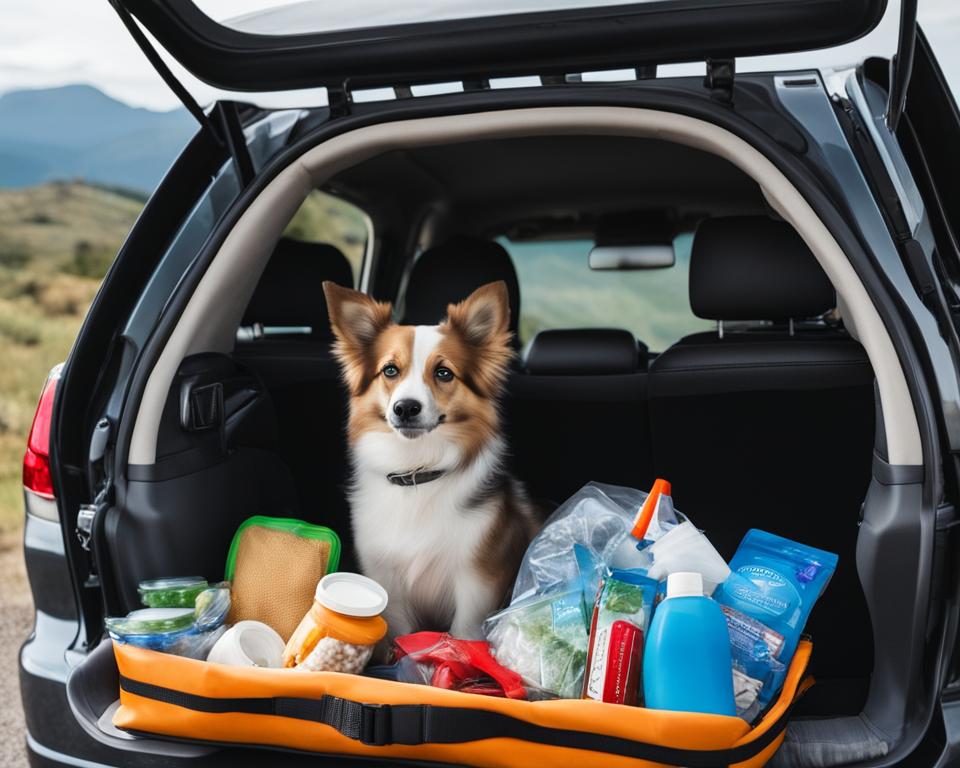
Before setting out on your next car travel with pets, it’s important to prioritize their health by scheduling a veterinary visit. This preemptive step not only ensures peace of mind but is also an opportunity to assemble a pet first-aid kit and complete your preparations for packing a dog travel kit.
Importance of a Pre-Travel Checkup
As a responsible pet owner, ensuring your furry companion’s well-being is crucial. A comprehensive pre-travel checkup can identify any potential health issues that might impact your trip. This exam may include a thorough physical evaluation and discussions about your dog’s travel exposure and experiences. Whether it’s a weekend getaway or an extended road trip, ensuring your pet’s physical and mental readiness is key for smooth, stress-free car travel with pets.
Up-To-Date Vaccinations and Records
Maintaining current vaccinations is more than just a health measure—it’s often a requirement for travel and lodging. Your veterinarian will help you verify that all immunizations are up to date, including rabies, which is essential for interstate and international travel. Moreover, bringing documentation of your dog’s medical history and vaccinations can expedite emergency care if needed—making these records integral components of your dog travel kit. In the face of unexpected situations or regulatory checks, you’ll be prepared with all necessary information at hand.
Before initiating your journey, ensure that the packing of a dog travel kit is complete with all the essentials your canine companion might need. Remember, echoing the comforts of home while on the road can significantly decrease travel anxiety for both you and your beloved pet.
Choosing the Right Crate or Restraint System
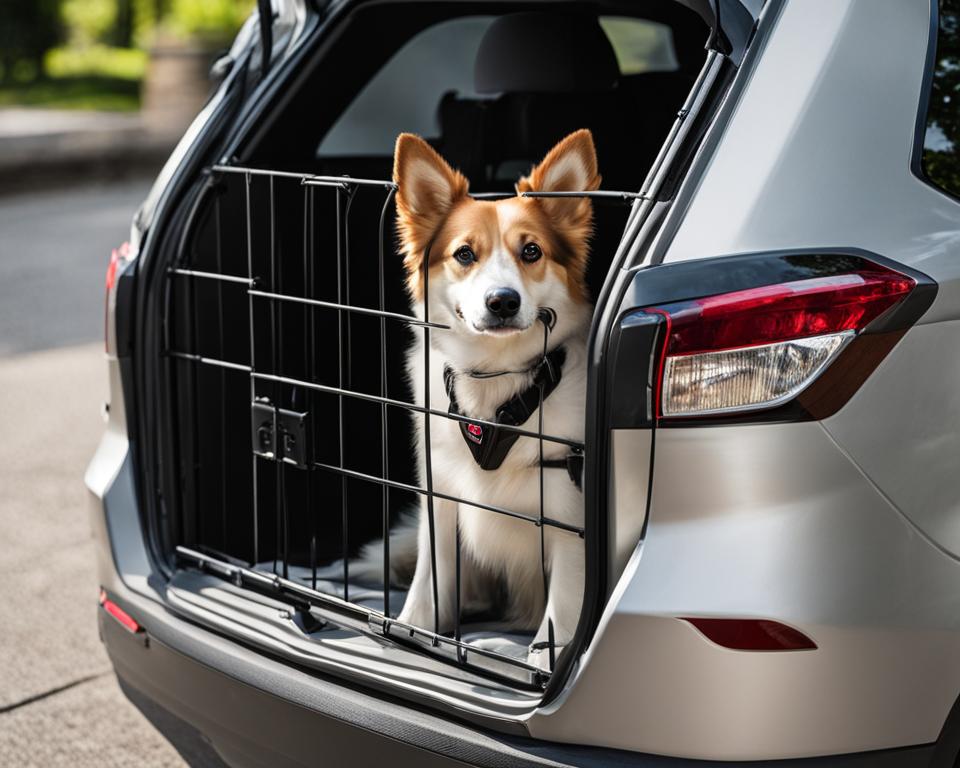
When it comes to road trip essentials for dogs, selecting an appropriate crate or restraint system should top the list. It’s not only about comfort; it’s about safety, too. The right choice will keep your dog secure during your travels, ensuring that everyone in the vehicle can enjoy a safe journey. Let’s examine the must-have features for dog travel crates and the advantages of incorporating dog seatbelts or barriers into your travel plans.
Features of a Safe Car Crate for Your Dog
Your dog’s crate is their home away from home while on the road. It is crucial that the crate meets certain standards to safeguard your pet’s well-being. Here are the features to look for when choosing dog travel crates:
- Size: The crate should be spacious enough for your dog to stand, turn around, and lie down comfortably.
- Strength and Durability: It must be sturdy enough to withstand the rigors of travel.
- Leak-proof Bottom: An absorbent layer on the bottom will help keep your dog dry and the area clean.
- Proper Ventilation: Ensure the crate provides ample airflow to your dog, reducing potential respiratory stress.
- Clear Labeling: Affix a ‘Live Animal’ sticker with your contact information in case of emergencies.
| Feature | Importance | Checklist |
|---|---|---|
| Size | Ensures dog’s comfort and ability to move | Measure your dog’s height and length |
| Material | Affects durability and longevity | Look for high-impact plastic, metal |
| Interior | To prevent accidents and discomfort | Leak-proof, absorbent material |
| Ventilation | For proper air circulation | Opposing side vents with rims |
| Labeling | For quick identification and safety | ‘Live Animal’, contact info |
Equip your chosen crate with a comfortable pad, a water bottle, and a selection of toys to help your dog feel secure and entertained throughout the trip.
Benefits of Dog Car Seatbelts and Barriers
While crates are often the preferred method of travel, dog seatbelts and barriers offer alternative benefits that are worth considering:
- A seatbelt harness can keep your dog secured in a seat, providing them with a view of their surroundings which may lessen their anxiety.
- Travel barriers prevent your dog from jumping into the front seat, minimizing distractions for the driver and thereby increasing safety.
- In case of a sudden stop, a well-fitted dog seatbelt can prevent injury by restraining your dog from being thrown forward.
Making the right choice in your dog’s travel restraint is essential, and integrating these road trip essentials for dogs will help ensure a secure and enjoyable journey for all. Remember, the goal is to arrive at your destination with tails wagging.
Traveling with Dog by Car: Creating a Cozy Space
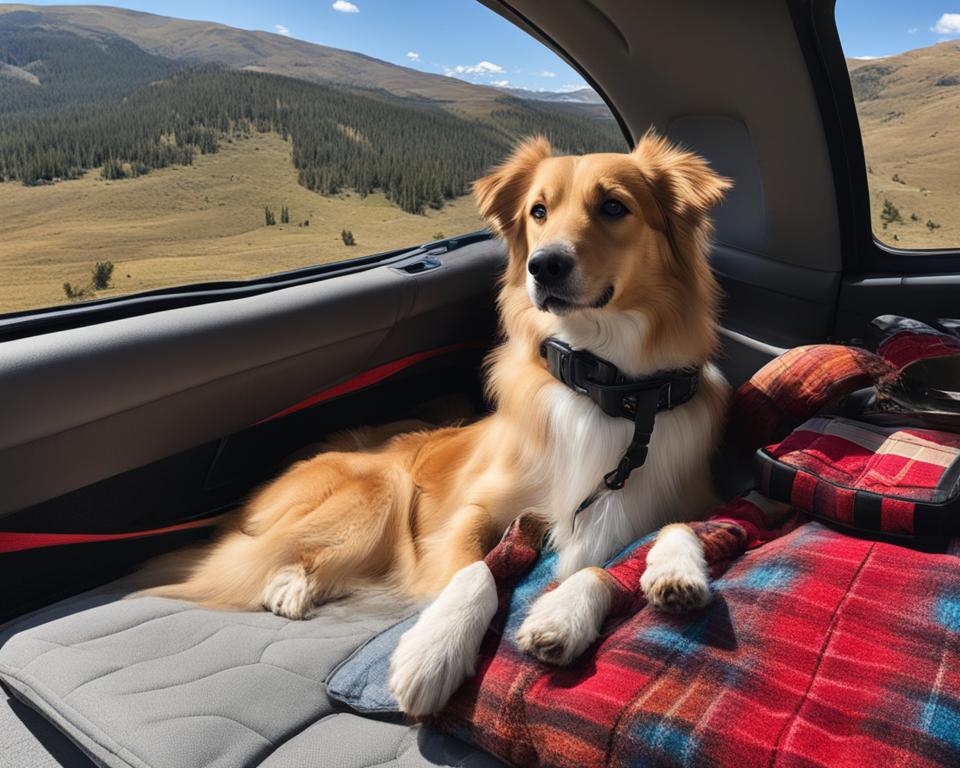
Embarking on a road trip with your canine companion requires more than just a destination. It’s about creating a journey filled with comfort and joy for both of you. Applying pet-friendly travel tips and setting up a snug space in your vehicle plays a crucial role in your dog’s welfare during your travels. This inclusive approach to car travel ensures your best friend feels secure, settled, and stress-free as miles roll by.
Investing in specialised car seats and customised floor covers not only protects the interior of your car but also contributes to a more comforting ride for your dog. While safety is paramount, pairing it with comfort can lead to happier, more relaxed journeys. Consider dog-friendly car travel tips like choosing a car seat made of soft, durable materials and a floor cover that’s easy to clean, providing a practical yet comfortable travel experience.
Stepping into the car should evoke as much calm and familiarity for your dog as stepping into your home. Achieving this invokes creating a cozy nook that replicates their known environment. Start with their favorite cushion or blanket; add in a couple of beloved toys to ease the unfamiliarity of travel.
| Item | Purpose | Benefit |
|---|---|---|
| Dog Car Seat | Secures and elevates your dog | Comfort with a view, reduces anxiety |
| Custom Floor Cover | Protects car’s interior | Easy cleaning, familiar texture beneath paws |
| Favorite Toys | Mental stimulation and comfort | Keeps your dog entertained, feels like home |
| Blanket or Cushion | Familiar scents and softness | Stress reduction, warmth, and security |
Whether it’s a long-haul drive or a quick jaunt, personalizing your pet’s travel area with these thoughtful touches can make all the difference. Remember, the aim is to ensure your dog’s car space is as welcoming and serene as their favorite spot on the living room floor. By following strategic pet-friendly travel tips, you’ll be well on your way to a paw-sitively pleasant road trip with your four-legged friend.
Packing a Dog Travel Kit: The Road Trip Essentials for Dogs
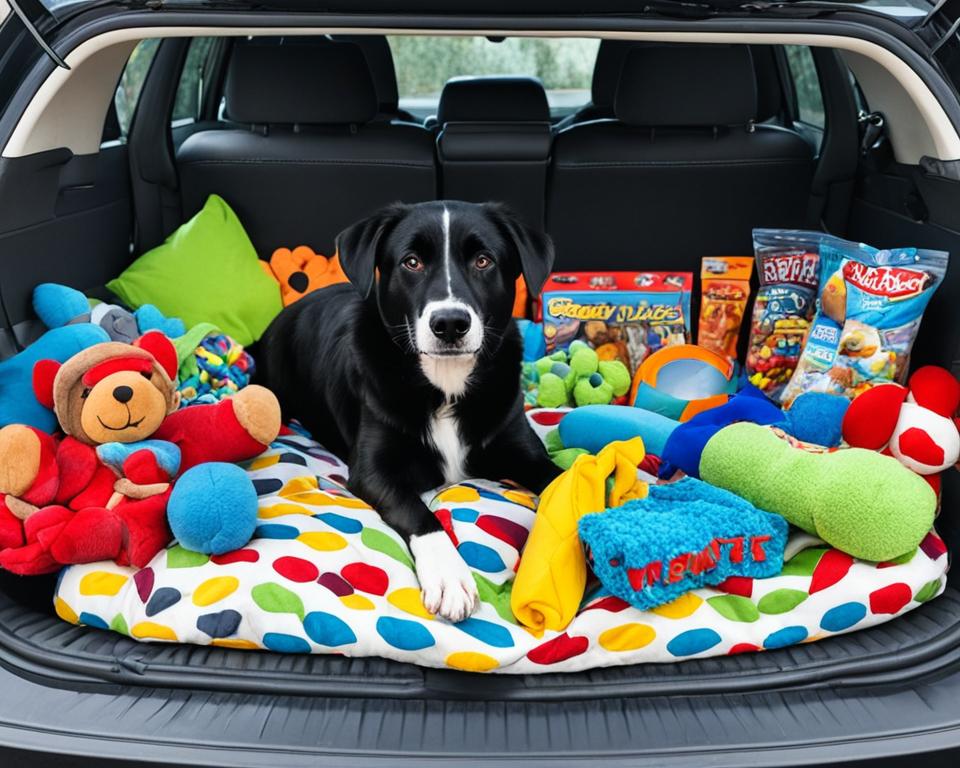
When you’re embarking on a journey with your loyal companion, packing a dog travel kit is as critical as your own suitcase. Your kit should cater to every potential need, ensuring your four-legged friend stays healthy, hydrated, and content throughout your adventure. Here’s how to assemble the ultimate road trip essentials for dogs that will guarantee a paw-sitive experience for you both.
Food, Water, and Medications
Begin by packing enough of your dog’s regular food to last the entire trip. Unfamiliar brands or ingredients may upset your dog’s stomach, so stick with what they know and love. Include an ample supply of bottled water to avoid the risk of gastrointestinal upset from drinking random tap water. For dogs with special dietary needs or on medication, make certain these are packed and easily accessible. Collapsible bowls are a great space-saving option that can offer a convenient way to provide meals and water on the go.
Pet First-Aid and Emergency Contact Numbers
A pet first-aid kit is an essential component of your dog travel kit. This should include basic first-aid supplies such as bandages, antiseptic wipes, tweezers, and a thermometer. It’s also wise to pack any special medications your dog requires. Having a list of emergency contact numbers, especially for a 24-hour veterinary hospital near your destination and your vet back home, is invaluable in the event of an emergency. Remember to carry updated records of your pet’s vaccinations and a recent photo to help others identify your dog if they get lost.
| Item | Quantity | Purpose |
|---|---|---|
| Dog’s Regular Food | Enough for Trip | Stomach Comfort & Familiarity |
| Bottled Water | Ample Supply | Hydration & Avoiding Sickness |
| Medications | As Required | Health Management |
| Collapsible Bowls | 2 (Food & Water) | Convenience & Portability |
| First-Aid Supplies | Varies | Emergency Preparedness |
| Emergency Contacts | N/A | Swift Reaction in Emergencies |
By carefully packing a dog travel kit, you’re nurturing a sense of home for your dog, no matter where the road takes you. With these preparations, you’ll have peace of mind knowing that you’re ready for any tail-wags or unforeseen paw-blem that may arise during your travels.
Feeding and Hydration Strategies On the Road
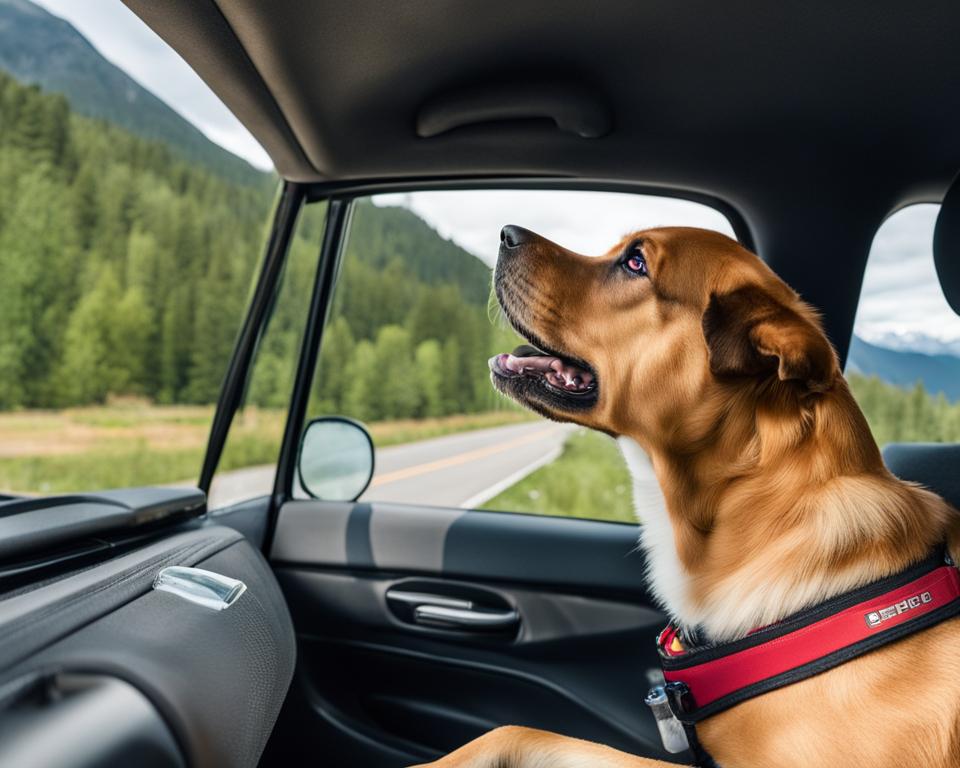
As you embark on dog-friendly road trips, it’s essential to consider how you will manage your furry friend’s feeding and hydration. The routines you set for meal times and access to water can play a significant role in comfort and health during your travels. Knowing the best ways to travel with a dog involves understanding their dietary needs and how to meet them when you’re both away from home.
Managing Meal Times While Traveling
To prevent car sickness, provide your dog with a light meal about three to four hours before departure. This preemptive step is one of the key pet-friendly travel tips that seasoned travelers swear by. It’s best to avoid feeding your dog in a moving vehicle as this can exacerbate stomach upset. Instead, plan meal stops into your journey where you can give your dog time to eat and digest their food before continuing on the road.
Ensuring Access to Fresh Water
Hydration is just as crucial for your pet on the road as it is at home. Always carry an adequate supply of fresh water and consider bottled water for your pet to avoid gastrointestinal issues from unfamiliar water sources. Collapsible bowls are invaluable on road trips: they don’t take up much space and can be easily accessed so your pet can drink whenever necessary.
| Feeding and Hydration Need | Strategy | Benefits |
|---|---|---|
| Meal Timing | Light meal 3-4 hours before departure, scheduled meal stops | Minimized risk of car sickness, routine maintained |
| Feeding During Travel | No feeding in a moving vehicle, use of travel bowls | Safety for pet and passengers, ease of feeding management |
| Hydration | Frequent access to fresh or bottled water, use of collapsible bowls | Prevention of dehydration and waterborne illness, convenience |
Remember, with these thoughtful feeding and hydration strategies, you can make sure your road trip is a smooth and enjoyable experience for you and your best travel buddy.
Pet Identification and Documentation for Travel
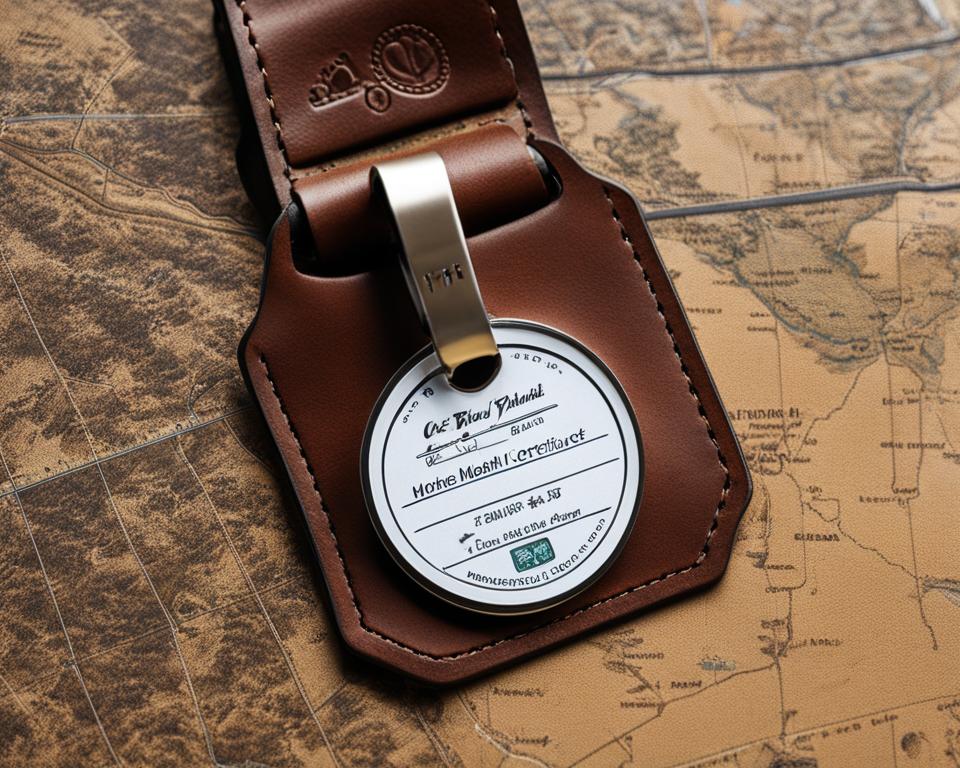
As you prepare for the adventure of traveling with your dog by car, ensuring your pet can be properly identified and carrying the right documents is crucial. A robust pet identification system and the necessary essential health certificates will not only give you peace of mind but also comply with legal requirements across various regions. Let’s delve into the specifics of how to properly prepare identification and documentation for your four-legged friend.
The Need for Visible ID Tags and Microchips
When it comes to pet identification, nothing beats the effectiveness of visible ID tags paired with a microchip. While the microchip provides a permanent form of identification, visible ID tags on your dog’s collar offer first-line information for anyone who might find your lost pet. Beyond your dog’s name and your home contact details, consider adding a temporary tag with the contact information of your travel destination to increase the chances of reuniting with your pet should they wander off in unfamiliar territory.
Carrying Essential Health Certificates and Records
Crossing state lines, or even more so when crossing into a different country, typically requires you to provide essential health certificates and vaccination records for your dog. It’s imperative that among your travel preparations, obtaining a health certificate dated within ten days prior to travel is top of the list. This documentation will facilitate smoother transitions through checkpoints and ensure that your travel plans aren’t hindered by bureaucratic hurdles.
| Document | Description | Reason for Necessity |
|---|---|---|
| ID Tag | Contact Information | Immediate identification and return if lost |
| Microchip | Permanent Identification | Backup if ID tags are lost or removed |
| Vaccination Records | Proof of Immunizations | Required for travel, lodging, and emergencies |
| Health Certificate | Veterinary Sign-off | Mandatory for interstate and international travel |
By ensuring your dog is easily identifiable and carrying proper health documentation, you’re clearing the path for a hassle-free experience traveling with your dog by car. Plus, you’re taking responsible steps to protect your pooch and the public’s health, regardless of where your travels may take you.
Navigating Dog-Friendly Lodging and Accommodations
As you and your canine companion wrap up a day of adventures on the open road, finding a comfortable retreat for night-time rest is paramount. A crucial part of travel planning involves seeking out dog-friendly lodging—a space that will welcome your furry friend with open arms. But securing accommodations that accept pets goes beyond just spotting a “pets allowed” note on a hotel’s profile; it’s about aligning with pet policies that ensure a smooth stay for you, your dog, and all other guests.
Finding and Booking Pet-Friendly Hotels
Initiating your search for pet-friendly hotels can be as simple as using dedicated online platforms that cater to pet owners. Yet, the devil is in the details. The dimensions of your dog, for instance, may direct your choices since some establishments have weight limits. Hence, when filtering your options, prioritize those spaces that explicitly match the specifications of your companion. Once a suitable spot is found, promptly secure your booking, as pet-friendly rooms tend to fill fast—especially during peak travel seasons.
Understanding Pet Policies and Expectations
After booking your accommodation, familiarize yourself with the premises’ pet policies. These rules outline everything from any additional fees for your canine guest to the specifics of where your pup might stretch their legs. Adherence to these guidelines is important not just for courtesy’s sake, but also to foster an environment of trust and respect for all parties. Keeping noise to a minimum, never leaving your dog unattended in the lodging space, and being vigilant in cleaning up after their outdoor excursions are all part of being a thoughtful guest. This conscientious attention to policy and decorum ensures that the pathway for future four-legged friends remains open and welcoming in these hospitable establishments.
FAQ
What are some essential pet-friendly travel tips for car travel with dogs?
Key pet-friendly travel tips for car travel with dogs include ensuring your dog is comfortable with car rides, using an appropriate crate or restraint system, packing a travel kit with food, water, and medications, managing your dog’s feeding and hydration on the road, and making regular pit stops for exercise and bathroom breaks.
How can I assess my dog’s comfort with car rides prior to a long trip?
Start by introducing your dog to the car in a non-moving state, then take short rides, gradually extending the duration. Observe your dog’s behavior for signs of stress or enjoyment. This helps you understand how your dog might handle longer trips and allows you to make necessary adjustments for their comfort.
How important are regular pit stops during dog-friendly road trips?
Regular pit stops are essential for your dog’s wellbeing during road trips. They provide an opportunity for your dog to stretch, exercise, relieve themselves, and drink water. These breaks can significantly reduce travel stress and promote a more pleasant journey for both you and your pet.
Why is a pre-travel veterinary checkup important?
A pre-travel veterinary checkup ensures that your dog is healthy and fit to travel. It’s also the time to update vaccinations, review records, and discuss any necessary medications with your vet. Proper health certifications may be required for staying at pet-friendly accommodations or crossing state or country borders.
What features should I look for in a safe car crate for my dog?
A safe car crate should be sturdy, have sufficient ventilation, a leak-proof bottom with absorbent material, and enough space for your dog to move comfortably. Ensure it has a “Live Animal” sticker, contains comfortable bedding, and that your contact information is clearly visible.
How can I create a cozy space for my dog in the car?
Create a comfortable spot in the car by investing in dog-friendly car seats or covers that protect your vehicle’s interior and provide a soft area for your dog. Bring familiar items like their favorite toys or blankets to help them feel secure and comfortable during the trip.
What should be included in a dog travel kit?
A dog travel kit should contain your dog’s regular food, fresh bottled water, any medications or special dietary needs, and collapsible bowls. Don’t forget a pet first-aid kit, emergency contact numbers, a current photo of your dog, and all necessary health and vaccination records.
What are some tips for managing my dog’s meal times and hydration while traveling?
Feed your dog a light meal 3-4 hours before beginning your road trip and schedule meal times during your stops, never in a moving vehicle. Offer fresh bottled water regularly to avoid gastrointestinal distress from unfamiliar water sources.
Why are visible ID tags and microchips important when traveling with my dog?
Visible ID tags on your dog’s collar and a microchip significantly increase the chance of being reunited with your dog if they get lost. ID tags should include your current contact information and any temporary details relevant to your travel destination.
How do I navigate dog-friendly lodging and what should I know about pet policies?
Research and confirm dog-friendly accommodations in advance. Make sure you understand the specific pet policies, including additional fees, size restrictions, and designated dog areas. Always supervise your dog closely and maintain a clean, damage-free environment during your stay.

